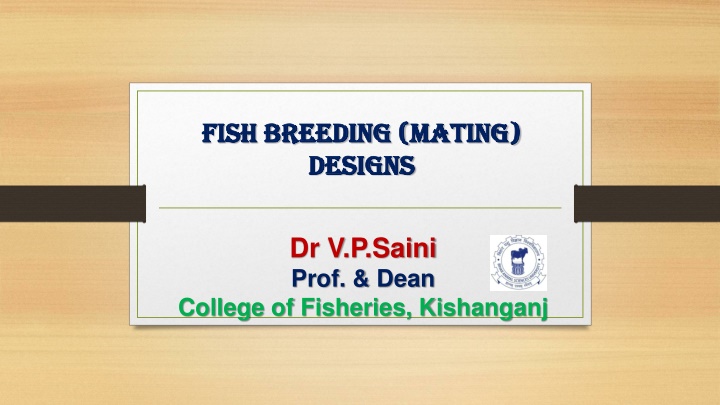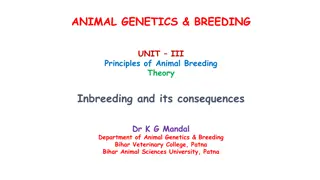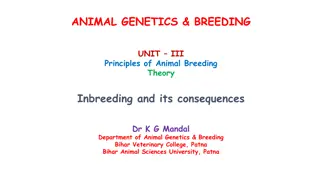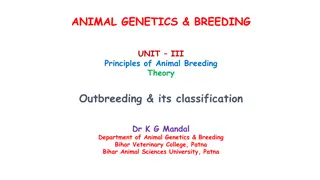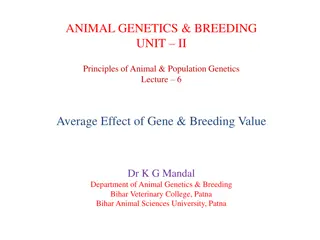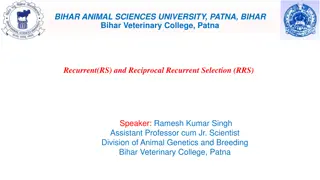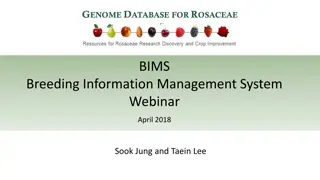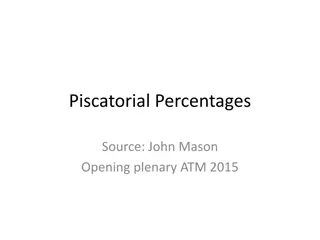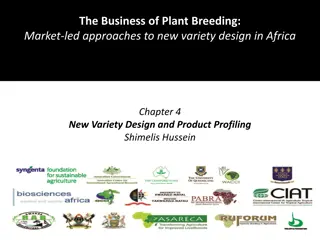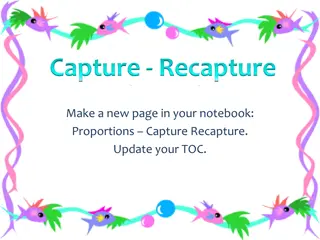Fish Breeding Mating Strategies and Designs for Effective Population Management
Designing mating strategies to maximize the effective breeding population in fish hatcheries is crucial for maintaining genetic diversity and overall fitness. Random mating, simple paired mating, factorial mating, and other breeding designs are discussed to help hatchery managers improve breeding control and success rates.
Download Presentation

Please find below an Image/Link to download the presentation.
The content on the website is provided AS IS for your information and personal use only. It may not be sold, licensed, or shared on other websites without obtaining consent from the author.If you encounter any issues during the download, it is possible that the publisher has removed the file from their server.
You are allowed to download the files provided on this website for personal or commercial use, subject to the condition that they are used lawfully. All files are the property of their respective owners.
The content on the website is provided AS IS for your information and personal use only. It may not be sold, licensed, or shared on other websites without obtaining consent from the author.
E N D
Presentation Transcript
FISH BREEDING ( FISH BREEDING (MATING) DESIGNS DESIGNS MATING) Dr V.P.Saini Prof. & Dean College of Fisheries, Kishanganj
Introduction Random Mating Simple Paired Mating Factorial Mating Diallel Mating discuss today? What we will
INTRODUCTION Designing mating strategies to maximize Ne (effective breeding population) is most useful if the hatchery manager can control breeding to some degree, usually through application of PIT tags, induced spawning, in vitro fertilization, and larval rearing. Cryopreservation also permit greater control over breeding. The following mating schemes rely on the brood stock manager s control
RANDOM MATING Nonrandom mating in fish hatcheries is generally undesirable Consequently, genetic diversity of hatchery seed/fish may be lost with a potential for reduced fitness when stocked in a different environment. Since, in most cases, hatchery managers do not know the details of reproductive behavior in nature, attempting to mimic the unknown is likely to be off the mark, thus, creating high risk of genetic hazards occurring, perhaps resulting in disruption of naturally evolved breeding behaviours and reduced fitness.
The success of a random mating strategy in meeting both production and genetics goals in a captive broodstock programme hinges on two major requirements. First, a very large population of mature broodfish, perhaps on the order of 2,000 adults is necessary. Second, the hatchery manager must be able to sample individuals in a random, unbiased manner when selecting broodfish to spawn.
SIMPLE PAIRED MATING Simple paired mating results from crossing one male with one female, preferably with no individual used more than once. This scheme, producing unique families, is considered to be the minimal standard for developing brood fish. Fish are marked and identified individually and their young identified by family, then pedigree matings and programs can be developed Simple paired mating is most useful when a relatively large number of unrelated mature fish are available to spawn
SIMPLE PAIRED MATING(4x4 ) F1 F2 F3 F4 F1 x F2 x F3 x F4 x
FACTORIAL MATING Factorial mating also involves mating one male with one female but may require spawning an individual of the least numerous sex with multiple is most useful when the number and sex of broodfish is limiting because it results in the use of all available broodfish and increases the diversity of alleles passed to the next generation. Factorial mating is a more complex, labour-intensive, controlled breeding strategy than the simple one-on-one, and its execution is enhanced by gamete extension and subdivision methods. For example, when females are the limiting sex, then an egg lot from a female is partitioned or subdivided into aliquots, each of which is fertilized by a different male until all males are used
FACTORIAL MATING F1 F2 F3 F4 F5 F6 F1 X X X F2 X X X X F3 X X X F4 X X F5 X X X F6 X X X
DIALLEL MATING Diallel mating is a variation of the factorial mating scheme and is most useful when developing captive brood stock from an imperiled donor population whose numbers have dropped drastically low. In that case, all fish are used to make all possible combinations of matings to maximize genotypic combinations according to a matrix format. Each male is bred with each female. Although not increasing Ne above that obtained in simple factorial matings, it does maximize genotypic diversity in a population that has lost some allelic diversity and likely to lose more shortly.
This has the effect of producing new genotypes some of which may confer high fitness in the progeny Factorial mating schemes, and in extreme cases, diallel matings, are recommended for breeding some endangered species and are currently being employed in various captive propagation fishes. The single matings may be between two pure breeding lines, P1 and P2. In a full diallel, all parents are crossed to make hybridsin all possible combinations. The set of crosses so produced is called the diallel cross and its analysis is called diallel analysis.
The The diallel diallel analysis combining combining ability (parental (parental lines) lines) and analysis helps ability viz viz. ., , general and the the specific helps to to estimate general combining specific combing estimate the combining ability combing ability the genetic genetic parameters ability (GCA) (GCA) of of the ability (SCA) (SCA) of of crosses parameters and and the parents the the parents crosses. . The The diallel diallel analysis Griffing Griffing ( (1956 1956) ). . analysis has has been been proposed proposed by by Hayman Hayman ( (1954 1954) ) and and Hayman Hayman pointed assumptions, assumptions, viz of of parents, parents, lack epistasis epistasis and pointed out viz. ., , random lack of of maternal and no no multiple multiple allelism out that random mating, maternal effects, allelism. . that diallel diallel analysis mating, normal normal segregation, effects, no analysis is is based segregation, heterozygosity no linkage linkage among among genes, based on heterozygosity genes, no on certain certain no
Diallel crossing (6x6 diallel) F1 F2 F3 F4 F5 F6 F1 xx X X X x X F2 X xx X X X x F3 X X xx X x X F4 X X X xx X x F5 X X X X xx x F6 X X X X X xx X- Crosses between the stock xx- Crosses withinstock
